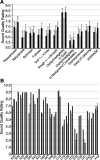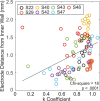A Dynamically Focusing Cochlear Implant Strategy Can Improve Vowel Identification in Noise
- PMID: 29529006
- PMCID: PMC6129442
- DOI: 10.1097/AUD.0000000000000566
A Dynamically Focusing Cochlear Implant Strategy Can Improve Vowel Identification in Noise
Abstract
Objectives: The standard, monopolar (MP) electrode configuration used in commercially available cochlear implants (CI) creates a broad electrical field, which can lead to unwanted channel interactions. Use of more focused configurations, such as tripolar and phased array, has led to mixed results for improving speech understanding. The purpose of the present study was to assess the efficacy of a physiologically inspired configuration called dynamic focusing, using focused tripolar stimulation at low levels and less focused stimulation at high levels. Dynamic focusing may better mimic cochlear excitation patterns in normal acoustic hearing, while reducing the current levels necessary to achieve sufficient loudness at high levels.
Design: Twenty postlingually deafened adult CI users participated in the study. Speech perception was assessed in quiet and in a four-talker babble background noise. Speech stimuli were closed-set spondees in noise, and medial vowels at 50 and 60 dB SPL in quiet and in noise. The signal to noise ratio was adjusted individually such that performance was between 40 and 60% correct with the MP strategy. Subjects were fitted with three experimental strategies matched for pulse duration, pulse rate, filter settings, and loudness on a channel-by-channel basis. The strategies included 14 channels programmed in MP, fixed partial tripolar (σ = 0.8), and dynamic partial tripolar (σ at 0.8 at threshold and 0.5 at the most comfortable level). Fifteen minutes of listening experience was provided with each strategy before testing. Sound quality ratings were also obtained.
Results: Speech perception performance for vowel identification in quiet at 50 and 60 dB SPL and for spondees in noise was similar for the three tested strategies. However, performance on vowel identification in noise was significantly better for listeners using the dynamic focusing strategy. Sound quality ratings were similar for the three strategies. Some subjects obtained more benefit than others, with some individual differences explained by the relation between loudness growth and the rate of change from focused to broader stimulation.
Conclusions: These initial results suggest that further exploration of dynamic focusing is warranted. Specifically, optimizing such strategies on an individual basis may lead to improvements in speech perception for more adult listeners and improve how CIs are tailored. Some listeners may also need a longer period of time to acclimate to a new program.
Conflict of interest statement
The authors declare no conflicts of interest.
Figures






References
-
- Bates D., Maechler M., Bolker B., et al. Fitting linear mixed-effects models using Ime4. J Stat Softw, 2015). 67, 1–48..
-
- Berenstein C. K., Mens L. H., Mulder J. J., et al. Current steering and current focusing in cochlear implants: Comparison of monopolar, tripolar, and virtual channel electrode configurations. Ear Hear, 2008). 29, 250–260.. - PubMed
Publication types
MeSH terms
Grants and funding
LinkOut - more resources
Full Text Sources
Other Literature Sources
Medical
Miscellaneous

